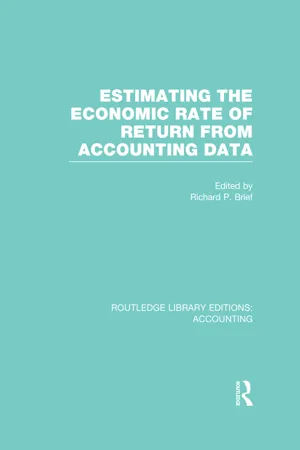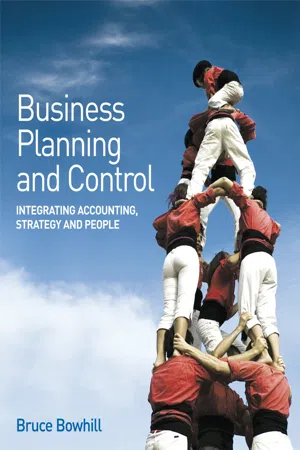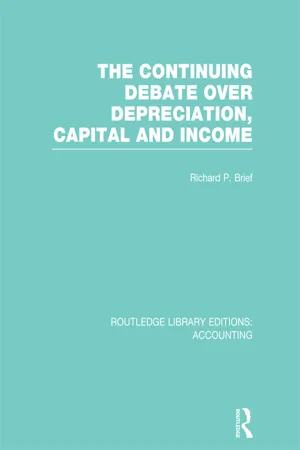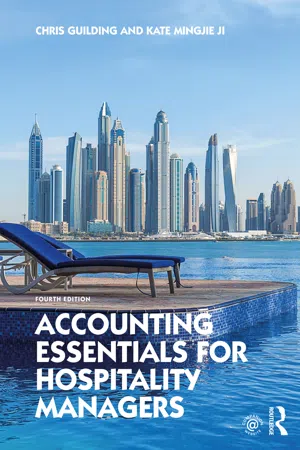Business
Accounting Rate of Return
Accounting Rate of Return (ARR) is a financial metric used to evaluate the profitability of an investment. It is calculated by dividing the average annual accounting profit by the initial investment cost. ARR provides a simple way to assess the potential return on an investment and is often used in conjunction with other financial metrics to make investment decisions.
Written by Perlego with AI-assistance
Related key terms
1 of 5
9 Key excerpts on "Accounting Rate of Return"
- Richard Brief(Author)
- 2013(Publication Date)
- Routledge(Publisher)
On the Use of the Accounting Rate of Return in Empirical ResearchGeoffrey Whittington*IntroductionAccountants are acutely aware that, despite the proliferation of Accounting Standards, published financial statements contain a good deal of subjective judgment and variety of practice, which make them not strictly comparable between the same company for different years (time series analysis) or between different companies for the same year (cross-sectional analysis). Furthermore, the recent debate on accounting in a period of rapid inflation has served to emphasise that accounting measures of value and income are very different from those of the economist, and a series of academic papers, Harcourt [1965] and Solomon [1966] being seminal works, has demonstrated that there can be important divergences between the Accounting Rate of Return (ARR)1 and the Internal Rate of Return (IRR) on investment, the latter being the more relevant return for the appraisal of economic performance. In these circumstances, it is not surprising that many accountants are sceptical of the value of using the ARR, calculated from published accounts, in empirical research, particularly in economics,2 but also in the area of accounting and finance.In this paper, we shall be concerned with the measurement of economic performance ex post i.e. with the comparison of the observed ARR for a year, or the average for a number of years, with the IRR. The latter is defined as that rate of discount which will give a zero initial Net Present Value of the lifetime cash flows of a project or (in the case of the whole firm) a group of projects. The calculation of an ex post IRR for comparison with an ARR calculated from financial reports has a serious practical drawback in the case of a continuing firm: IRR requires estimates of all future cash flows, which will be extremely subjective in a world of uncertainty. It is this practical obstacle to calculating IRR or any other measure of economic income (explored comprehensively by Kaldor[1955]. pp. 62–64). which makes ARR, despite its possible deficiencies, a popular practical alternative for appraising the ex post profitability of companies, e.g. in monopoly investigations. In the literature investigating the relationship between ARR and IRR (e.g. the papers by Har-court and Solomon) it is customary to make golden age assumptions of complete certainty about the future, so that ex ante and ex post IRRs are identical (expectations are always fulfilled). It might reasonably be argued that this biases the case against ARR, since we are comparing a practical measure (ARR) with a theoretical ideal which is impractical (IRR under conditions of certainty). It should also be noted that the IRR is not always an ideal measure of economic performance even under conditions of- eBook - PDF
Business Planning and Control
Integrating Accounting, Strategy, and People
- Bruce Bowhill(Author)
- 2014(Publication Date)
- Wiley(Publisher)
[ 90 ] C H A P T E R 4 (i) Calculating average profit For project A the first step is to work out the average annual profit. The cash inflows from trading over the five years are 0 + £100,000 + £300,000 + £600,000 + £1,300,000 = £2,300,000. The asset cost £1,000,000 to purchase. The value at the end of the project was zero (nil residual value). Depreciation on the project is therefore £1,000,000. £ Net cash flow from trading 2,300,000 Depreciation 1,000,000 Profit over the five years 1,300,000 Average profit = £1,300,000 5 = £260,000. (ii) Calculate the ARR Divide the average profit by the investment, in this case £1,000,000. Therefore ARR = £260,000 £1,000,000 = 26%. If the ‘hurdle’ rate ARR of the organization was 25% then using this criterion in isolation, the investment would be acceptable. Figure 4.3 Accounting Rate of Return for project A Activity 4.2 Calculate the ARR of projects B and C. Note that some organizations quote the Accounting Rate of Return by dividing the average accounting profit by the average capital investment rather than the initial capital investment. For project A: Average capital investment = initial value + ending value / 2 = £1 000 000 + 0 / 2 = £500 000 Accounting Rate of Return would be £260,000 £500,000 = 52%. The advantages and disadvantages of Accounting Rate of Return Advantages The ARR technique is popular because: 1. It is familiar to many managers, for example, divisional managers are often assessed on accounting measures such as return on capital employed or return on investment. These accounting measures are very similar to ARR. 2. It considers the whole life of the project. [ 91 ] C A P I T A L I N V E S T M E N T D E C I S I O N S Disadvantages ARR treats all cash flows as being equally important, even though early cash flows are ‘worth’ more than later cash flows. - Richard Brief(Author)
- 2014(Publication Date)
- Routledge(Publisher)
Journal of Business Finance & Accounting, Vol. 18, No. 1 (January 1991), pp. 13–20.Peasnell, K.V. (1982), ‘Some Formal Connections between Economic Values and Yields and Accounting Numbers’, Journal of Business Finance & Accounting, Vol. 9, No. 3 (Autumn 1982), pp. 361–81.* The authors are respectively, Professor of Business Statistics and Accounting and Associate Dean of Academic Affairs. New York University, and Visiting Associate Professor of Accounting, State University ol New York at Albany. (Paper received March 1991)Passage contains an image THE ACCOUNTING REVIEWVol. 67, No. 2April 1992pp.411–426 The Role of the Accounting Rate of Return in Financial Statement Analysis
Richard P. BriefNew York UniversityRaef A. LawsonState University of New York at AlbanySYNOPSIS AND INTRODUCTION: The Accounting Rate of Return (ARR) is “not only a central feature of any basic text on financial statement analysis but also figures commonly in the evaluation by investment analysts of the financial performance of firms” (Whittington 1988, 261). Notwithstanding the prominence given to this financial ratio (Foster 1986, 77–79), many writers have warned that the ARR lacks economic significance and can be a very misleading measure of profitability. Fisher and McGowan (1983, 90), for example, conclude that “there is no way in which one can look at accounting rates of return and infer anything about relative economic profitability.” In the same vein, Rappaport (1986, 31) states flatly that the comparison of the ARR with the cost of capital is “clearly like comparing apples with oranges.”The limitations of using ARRs to estimate the economic rate of return have been discussed over the last 25 years; for example, Harcourt (1965), Solomon (1966), Kay (1976), Fisher and McGowan (1983), Salamon (1985), Edwards et al. (1987), and Brief and Lawson (1991). This research has focused mainly on the question of whether the ARR is a good proxy for the economic return and the literature contains virtually no discussion of other ways in which the ARR might be used in financial analysis. An important exception is Peasnell (1982b) who presents a common analytical framework connecting conventional economic concepts of value and yield and accounting models of profit and return. However, even here, the main emphasis is on the relationship between accounting and economic rates of return. This emphasis is quite evident in Peasnell’s concluding comment that “it is difficult to assign economic significance to accounting yields except either (1) as surrogate measures of IRR or (2)- eBook - PDF
Strategic Managerial Accounting
Hospitality, Tourism & Events Applications
- Tracy Jones, Helen Atkinson, Angela Lorenz, Peter Harris(Authors)
- 2012(Publication Date)
- Goodfellow Publishers(Publisher)
Average Annual Profit * 100 = %ARR Initial Investment There is an argument that as the investment by the end of year 6 is £0, due to depreciation, the average invested in the project (half the original investment) is a more realistic figure to use. Either formula can be used; as long as the same formula is used consistently valid comparisons can be made between projects. Given projects A and B have the same initial investment, same total profit returns and same life in years the ARR calculations are the same for each project. Average annual profits = total profits/number of year of project = £340,000/6 = £56,667 Average investment = initial investment + residual value at the end of the project/2 = £1,500,000 + £0/2 = £750,000 ARR Projects A and B (using average investment) £56,667 * 100 = 7.6% £750,000 ARR Projects A and B (using initial investment) £56,667 * 100 = 3.8% £1,500,000 If using ARR there is no difference in these two projects, they both make the same financial returns over the six-year period. It is a method more widely used with projects with a shorter time period and has a number of failings: 230 Strategic Managerial Accounting Using the average profit can disguises great variations in annual profits. In this example project B gives more profit returns in the earlier years compared to project A, but using ARR this is not recognised. It is based on profits, not cash flows. Profits are more open to variation, or even manipulation, due to accounting practices. For example, the depreciation method used will impact on annual profit levels. It is generally considered that cash flows are less open to accounting manipulation than profits so are a better measure of returns. Cash is a physical return that can be put in the bank or reused in further investments, whereas profit is a non-physical monetary value. Refer back to Chapter 2, section 3, for a detailed discussion of the differ-ence between profit and cash. - eBook - ePub
- Chris Guilding, Kate Mingjie Ji(Authors)
- 2022(Publication Date)
- Routledge(Publisher)
The average investment is a slightly more challenging concept to grasp, however. Try thinking of it as ‘The average amount of money invested in the asset during its life’. At the beginning of 20X0, it is evident that $8,000 is invested in the asset (i.e., the initial investment). At the end of the life of the asset, it is evident that $2,000 is effectively invested, as this is the amount that could be liquidated if the asset is sold. As the asset is worth $8,000 at the beginning of its life and $2,000 at the end of its life, its average value over the duration of its life is $5,000. This is the midpoint between $8,000 and $2,000 and can be computed as follows: ([$8,000 + $2,000] ÷ 2).As the average annual profit is $2,000 and the average investment in the asset is $5,000, the ARR can be computed as follows:At first glance, the ARR might appear conceptually appealing. It has major shortcomings, however. These shortcomings include:ARR =× 100 = 40 %$ 2 , 000$ 5 , 000- 1 The ARR fails to consider the period of the investment. Suppose a hotel is deciding whether to take the 40% ARR investment option with a 3-year life described in Box 14.1 or a second $8,000 investment option that has a 10-year life and an ARR of 38%. Both returns appear very high. Consequently, we are left to question: Would you like to make an investment that provides a very high return for 3 years or an investment that provides a very high return for 10 years? Let’s assume that the hotel in question generally makes an average return of 12% on its assets. By investing in the 10-year asset that provides a 38% ARR, it will be able to increase its average return on assets for 7 years longer than if it invests in the 3-year asset that provides a 40% ARR. In this case, it appears that the 10-year 38% ARR investment option is preferable to the 3-year 40% ARR option.
- 2 The ARR is based on accounting profits. These figures involve some apportioning of cash flows to different accounting periods (e.g., depreciation). As a result, profits are not ‘real’ in a tangible sense. They represent nothing more than the accountant’s ‘account’ of performance. Cash flows, however, are real, and it is the commercial reality of the timing of money entering and exiting the organisation, and not the accountant’s account, that we need to incorporate in the decision model.
- eBook - ePub
Markets, Unemployment and Economic Policy
Essays in Honour of Geoff Harcourt, Volume Two
- Philip Arestis, Gabriel Palma, Malcolm Sawyer(Authors)
- 2005(Publication Date)
- Routledge(Publisher)
With regard to the measurement of the rate of return, Geoff Harcourt made a seminal contribution through his paper ‘The accountant in a Golden Age’ (1965). This explored the relationship between the internal rate of return (IRR) measure favoured by economists, and the Accounting Rate of Return (ARR) produced by accountants and often used in empirical work by economists. The conclusions, based upon a much more thorough and systematic study than had previously appeared in the literature, were extremely pessimistic. As is so often the case, similar work was conducted at the same time on an entirely independent basis (by Ezra Solomon in the USA) and its results were published shortly after the Harcourt paper (Solomon 1966), whose results they confirmed. The papers by Harcourt (1965) and Solomon (1966) are now the standard original references in a literature on the significance of accounting rates of return, which has flourished during the three decades following their publication.The purpose of the present paper is to trace the course of that debate. In view of Geoff Harcourt’s contributions to the history of ideas, it is hoped that it is a fitting tribute to him to trace the history of one of his own ideas.1THE ACCOUNTANT IN A GOLDEN AGE Harcourt (1965) proposedto examine how accurate is the accountant’s measure of the rate of profit under Golden Age conditions where uncertainty is absent, expectations are fulfilled, and the rate of profit has an unambiguous meaning. The following question is asked: would the answer obtained by using the accountant’s rate of profit correspond with what is known, under the assumed conditions, to be the right answer, namely, that the ex post rate of return equals the ex ante one.(Ibid.: 66)In other words, the accountant’s calculation of the rate of return (ARR) was to be compared to the economist’s measure of the internal rate of return on investment (IRR), using identical raw data.The method used to assess the correspondence between the ARR and the IRR was computer simulation. Two basic cases were considered: a balanced stock of machines and a steadily growing stock of machines. In each case, there was a variant which allowed for the accumulation of financial assets, making four cases in all. For each of these cases, four different time patterns of cash flows (quasi-rents) from machines were assumed: constant (a ‘one hoss shay’pattern), falling, rising, and rising followed by falling. For each of the resulting sub-cases, two different accounting depreciation methods were tested: straight line and reducing balance. For each of the resulting sub-cases, the IRR was compared with the ARR, assuming various different rates of profit (IRR), lengths of life of machines and (where relevant) rates of growth of investment. - Daniel Adrian Doss, William H. Sumrall III, David H. McElreath, Don W. Jones(Authors)
- 2013(Publication Date)
- Taylor & Francis(Publisher)
221 8 Pay Me Now or Pay Me Later? The Minimum Attractive Rate of Return Your net worth to the world is usually determined by what remains after your bad habits are subtracted from your good ones. —Benjamin Franklin 1 Objectives The objectives of this chapter are to • Understand the concept of minimum attractive rate of return (MARR) • Understand the relationship between MARR and opportunity cost • Understand the relationship between MARR and rate of return • Understand the determination of MARR • Understand the MARR equations • Understand MARR applications Introduction The preceding chapters introduced notions of capital budgeting that accom-modated a consideration of rates of change and the internal rate of return (IRR). The IRR is a capital budgeting method involving an equating of net pres-ent value to the value of zero among numerous projects to determine which capital initiative alternative demonstrates the highest and best rate of return (ROR). Certainly, the IRR outcome must surpass a stated, acceptable ROR that must be achieved for a potential capital initiative to be deemed acceptable. Another method of investigating rate to influence the rendering of human investment decisions involves the notion of the MARR. The MARR is the established “minimum level of economic performance that it would like to realize on all investments.” 2 The establishing of this rate may occur under conditions of uncertainty during which organizations may not know the value of an effective interest rate. 2 222 Economic and Financial Analysis for Criminal Justice Organizations Another perception of MARR involves opportunity cost. The concept of opportunity cost encapsulates the notion that the “true cost of something” is what is given up (i.e., sacrificed) in order to receive benefit.- eBook - ePub
- Aneirin Owen(Author)
- 2007(Publication Date)
- Routledge(Publisher)
Payback occurs after seven and a half years. PBP can easily be adapted to the comparison of projects. Compare the payback period for the projects A, B and C below (all in £):Project A has the quickest payback. This can be interpreted to mean it carries the least risk and generates a profit most quickly. This does not mean, however, that it generates neither the largest profit nor the largest net cash flow over the whole life of the project. Sometimes projects with slower payback generate a larger profit over the whole life of the project. Although PBP is easily understood, there are drawbacks. It does not include the time value of money and it does not consider the post-payback cash profile.NPV, IRR and PBP are all based on cash, not profit. Yet many managers are accustomed to dealing with profit and may prefer a decision rule based on profit.Accounting Rate of Return The Accounting Rate of Return (ARR) is given by the average annual profits expected from a project, divided by the initial capital investment. When multiplied by 100, this delivers a percentage which managers and entrepreneurs can interpret. For instance, if the profits expected from a project averaged £100,000 and the initial capital was £1,000,000, the Accounting Rate of Return would be 10%. Consider the three examples set out below (all in £):The figures indicate project C is the most beneficial. No account, however, has been taken of the time value of money and the figures are based on arbitrary depreciation rates. Even so, profit is a familiar concept to managers and one which readily lends itself to a percentage of initial capital.Conclusions Each of the different decision-making techniques has advantages and disadvantages. PBP is well suited to smaller companies needing quick payback from investments. IRR and NPV are better suited to a larger company with a dedicated team of business analysts. ARR may suit a company where profits are subject to the close scrutiny of stock markets. A sensible approach is to use all four techniques on every potential investment decision and carefully compare the results. - David Whitman, Ronald Terry(Authors)
- 2022(Publication Date)
- Springer(Publisher)
3.3 MINIMUM ACCEPTABLE RATE OF RETURN (MARR) When using either the equivalence method or the rate of return method for comparing alternatives, a minimum acceptable rate of return, MARR, needs to be defined. The value of MARR is set as the lower limit for investment which is acceptable to an individual or a company. The MARR may vary from individual to individual, company to company, and even within the structure of a specific company. The lower bound for the MARR is generally set at the cost of capital, which reflects the expense of obtaining funds for a given project. How much higher the MARR is above the cost of capital depends on a particular company’s or individual’s position and the particular project. For example, an individual who borrows money at 5% interest rate in order to invest in a profit-generating project would have an MARR of at least 5%, but would probably want to set the MARR at, say, 10% in order to generate a net increase in his/her personal worth based on the estimated profitability of the project. Similarly, if individuals are using their own funds to invest, their cost of capital would be the interest rate that their money is currently earning in a savings account, certificate of deposit, or other investments. A company’s MARR is usually set by the portfolio of projects in which the 3.4. EQUIVALENCE METHODS 27 company can invest. That is, what is the minimum interest that a company can earn by investing its money in what it would consider to be a “guaranteed” success? For engineers performing economic evaluations for their companies, the MARR will be provided by upper management so that they will not have to make that determination. 3.4 EQUIVALENCE METHODS In the equivalence methods to determine either the acceptability of a single project or to choose the “best” project, the MARR is used as the interest rate in present, future, or annuity calculations.
Index pages curate the most relevant extracts from our library of academic textbooks. They’ve been created using an in-house natural language model (NLM), each adding context and meaning to key research topics.








